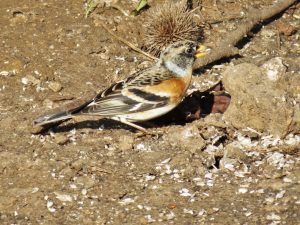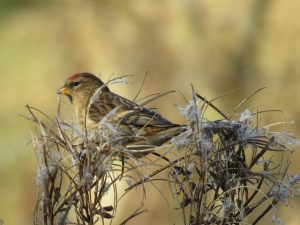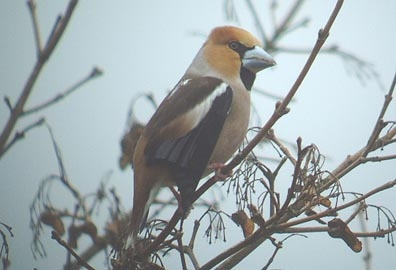Nature Note – More Finches From Afar

Brambling
This finch can sometimes be found in mixed flocks with the closely related Chaffinch and can easily be overlooked.
However, Bramblings have a favourite food; beech nuts. As good numbers have been seen along the east coast this month there would appear to be some hungry Bramblings around. Look out for them on the ground under mature beech trees but also dropping into stubble fields to feed or at times visiting garden feeders.
The males have a black head which in winter is often mottled with white. The pink of male chaffinches is replaced with bright orange and when the bird flies away both a white rump and a forked tail are visible. The grating, nasal call is unlike the ‘pink’ of the Chaffinch.
In winter Bramblings can be found near the Beacon Hill car park or at Rutland Water.

Redpoll
Redpolls can sometimes be found in mixed flocks with Siskins as both species feed on the small cones of alder trees. You are just as likely to see two or three Redpolls feeding on the seed-heads of wildflowers as you are to see them in alder trees.
Currently there are three species of Redpoll recognised in the UK. The Lesser Redpoll is the commonest of these. It breeds in (mainly) the North of England and Scotland and it migrates both within the country and into the UK from the Continent. It is the species you are most likely to see.
Common (also known as Mealy) Redpolls are slightly larger and paler whilst Arctic Redpolls are paler still and have a tiny bill. These species come from further north.
For now, concentrate on first finding a ‘Redpoll’. You are looking for a small, streaked, mainly brown finch with a small pointed bill and a red spot on the forehead.

Hawfinch
The Hawfinch is a relatively rare and there are no known breeding areas in Leicestershire. However there have been several reports of birds flying over Leicestershire migration watch points this autumn and there is every chance that wintering birds will be found.
Small groups or individuals are sometimes located with feeding Greenfinches and Chaffinches and if none are located locally, known regular wintering sites are in Derbyshire, Nottinghamshire, or Norfolk.
The Hawfinch is a large finch with a very large bill and thick neck. It can break open cherry stones. The bill is silver/blue coloured and the plumage is mainly a mix of rusty brown, buff and white.
All three species (Brambling, Redpoll and Hawfinch) were recently recorded in a garden adjacent to Rutland Water.
David Scott




 The Chronicle needs you
The Chronicle needs you

